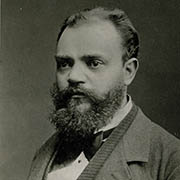Previous editions of Dvořák’s Piano Concerto op. 33 have been inadequate. After detailed examination of the sources the work is now being published in its original form.
The first edition of Antonín Dvořák’s Opus 33 was published in mid-1883, more than five years after its première and almost seven years after its completion. Dvořák revised the work many times before its publication. The autograph score contains numerous corrections, pastings over, crossings out and additions, and shows the development of the work in three respects: the form of the work, the orchestral accompaniment and the solo part. The formal structure was improved by Dvořák, particularly in the first movement: bars were added and sections of the work were shortened, so that in the transitions a more well-balanced form emerged. In addition the orchestral tone colour was developed down to the finest detail, with finely-graded dynamic, articulation and phrasing markings. However, most of the alterations relate to the solo part which Dvořák revised thoroughly in terms of its effectiveness, virtuosity and tonal sound, but without destroying the fineness and transparency of the work. The revision of the piano part did not follow the composer’s ideas, but reflected the opinions of many pianists, critics, publishers and musicologists. Their criticism was surely also a reason for the long search for a publisher who would take on the work. The manuscript was apparently used as the score for the first performance, and therefore contains notes and comments by the conductor.
The reason that the piano concerto was underrated for so long is because the solo part did not correspond with ideas of a solo concerto back them, which demanded virtuosity, individuality and an extrovert performance. A version arranged by Vilém Kurz was included in the critical Complete Edition of Dvořák’s works in 1919 (Berkovec/Šolc, 1956).
This new edition is far different to the 1919 version, which cannot be regarded as a valid alternative. By contrast, it aims to reconstruct Dvořák’s airy, witty and transparent sound world in passages which are unclear.
An important source for the new edition is the copy of an early version from the papers of Leoš Janáček. In some passages this offers an insight where sections have been pasted over, rubbed out or crossed out in the autograph score. So, it was possible to newly interpret an unclear transition into the third movement.
The manuscript of the work cannot simply be transcribed. Dvořák wrote hastily – sometimes clearly, sometimes not, sometimes in detail, and sometimes incomplete, and from time to time inconsistently. The differences between > and ^ and between dots and strokes are not always clear. However, in some passages it can be observed that Dvořák clearly used different articulation and dynamic markings which were then standardized in the first edition.
The Breslau publisher Hainauer published the edition swiftly, and it is unlikely that any lengthy discussion with Dvořák took place about this. Besides this, it is possible that Dvořák needed to give his undivided attention to his now-blossoming career. Hainauer should therefore not be criticised for the fact that many incomplete and unclear passages in the manuscript were included in published version.
The new edition uses the first printed edition (full score, solo part and orchestral parts) as the primary source, but compares it with the autograph in order to indicate unclear passages and, where possible, to suggest alternatives or even make a clear choice about these. The result is a new step in revealing the sound world Dvořák imagined. As a substitute for the original piano score, which was not made by Dvořák, we are publishing a modern piano score by Karel Šolc.
Robbert van Steijn
(from [t]akte 1/2018)



